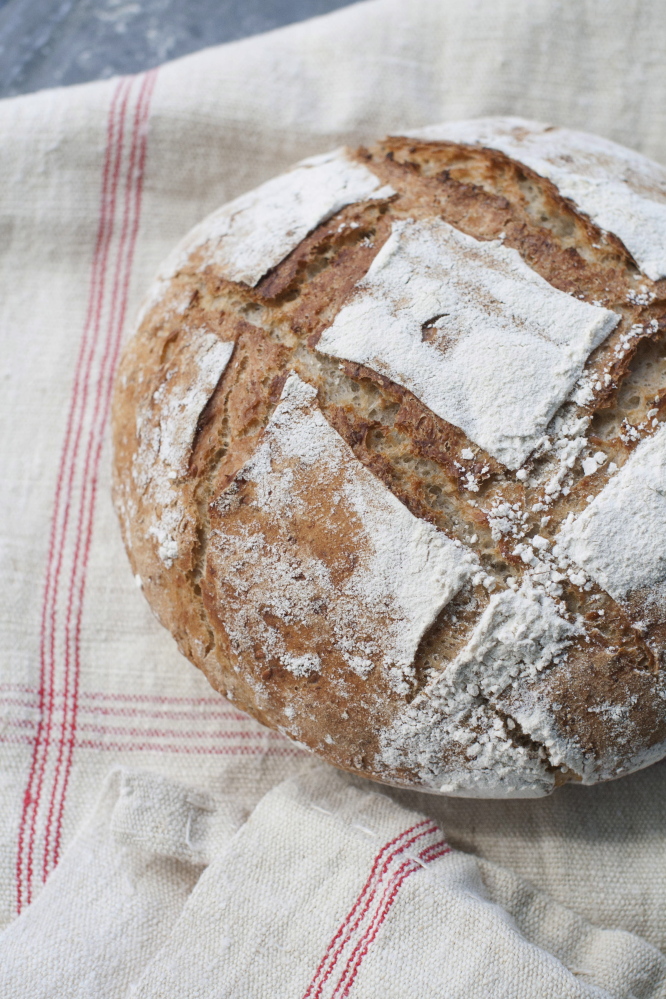Homemade bread really is the difference between a good sandwich and a great one. This especially important when contemplating back-to-school lunches. A brown-bag lunch should be something to look forward to. And even a peanut butter and jelly sandwich becomes a treat when good bread is involved.
But we tend to be intimidated by from-scratch bread baking. I certainly felt that way after recently enjoying an artisanal loaf. I wanted to recreate it at home, but I knew my oven – as opposed to a brick oven – would be my greatest stumbling block. I figured it was hopeless, until I stumbled onto a recipe by Leslie Mackie, chef-owner of Macrina Bakery and Cafe in Seattle.
The technique is simple, and it wonderfully replicates a traditional bread oven. It involves baking the loaf in a cast-iron double Dutch oven (the sort in which the lid is an overturned skillet). With its tight-fitting lid, the preheated cast-iron pot traps the moisture inside, where the loaf simultaneously rises as it bakes, creating a soft yet hearty interior texture and a deep golden brown crust.
Making the bread was half science experiment, half baking, and I couldn’t wait to get started. I adapted the recipe to suit my taste, adding twice as much cereal for texture and adding rye flour for tang. The multiple rises contribute to both the texture and the development of flavor.
One easy tip when making this bread is to purchase a raw multi-grain hot cereal and use that instead of buying bags of individual grains, such as flax, oats, barley, rye, wheat, etc. I also like to add sunflower seeds.
The only difficult part of this recipe is heating and handling the Dutch oven. I place the Dutch oven on rimmed baking sheet to make this job easier and safer. It is especially helpful when removing the “lid” after the first 30 minutes of the baking time.
DUTCH OVEN MULTIGRAIN BREAD
Makes one 9-inch loaf
For this recipe you’ll need a Dutch oven in which the lid is a skillet. The pan acts as a cover when overturned and set on top of the pot. Several different companies make this style cast-iron Dutch oven, sometimes called a double Dutch oven.
21/4 cups all-purpose flour, plus more as needed for sprinkling
21/4 cups lukewarm water (about 80 F)
2/3 cup multigrain hot cereal (uncooked)
3 generous tablespoons honey
1 envelope (21/4 teaspoons) active dry yeast
1/2 cup stone-ground rye flour
2 teaspoons kosher salt
Line a medium bowl with a clean kitchen towel, then sprinkle it heavily with flour. Set aside.
In a large bowl, combine the warm water, cereal and honey. Let soak for at least 30 minutes and up to an hour. Sprinkle the package of yeast over the cereal, whisk gently, then let stand for 3 minutes.
Add the 2 1/4 cups of flour, the rye flour and the salt. With a rubber spatula, mix together for 2 or 3 minutes by pulling the spatula through the dough and flipping. Cover the bowl with plastic wrap and let rise at room temperature (or in a warm place, about 75 F) until the dough has doubled in size, about 2 hours.
Remove the plastic wrap. Lightly sprinkle the top of the dough with all-purpose flour, then push the dough down and pick it back up at the sides. Knead a couple of times in the bowl, adding a little flour to make it less sticky. Flip the dough over so the seam of the dough is on the bottom, then cover with plastic wrap. Let rise for another 1 to 2 hours, or until doubled.
Knead again in the bowl and add a bit of flour if necessary. Transfer the dough to a floured work surface. Knead a couple of times and gently round the dough to tighten the loaf. Place the dough in the floured and towel-lined medium bowl with the seam side up. Cover the top of the loaf with the ends of the towel or with another clean towel. Let rise until the loaf feels springy, about 11/2 to 2 hours.
At least 1 hour before baking, place a 5-quart cast-iron double Dutch oven on a rimmed baking sheet (to make it easier to transfer in and out of the oven). Place the cover, overturned, next to it. Place the entire thing in the oven and heat at 400 F.
When the dough is ready, carefully remove the baking sheet from the oven. Using the towel to transport it, invert the loaf of bread onto the overturned cover. Use a paring knife to quickly score the top with a 4-inch square about 1/4 inch deep. Being very careful, overturn the pot onto the lid to cover the loaf.
Return the baking sheet to the oven. Bake, covered, for 30 minutes, then carefully remove the top and bake uncovered on the “lid” until the loaf is a deep golden brown, another 20 minutes. Transfer the loaf to a wire rack to cool for 1 hour before slicing.
Send questions/comments to the editors.


